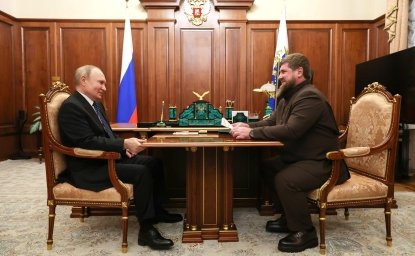
A blog of the Kennan Institute
Friday marked the fourth day of the Ukrainian forces’ incursion deep into Russian territory in the Kursk oblast, a region bordering Ukraine to the west, Belgorod oblast to the south, and Voronezh to the east. Ukraine may have succeeded in pressuring the Russian side to redeploy some of the units that were instrumental in several advances Russia claimed in the Kharkiv and Donetsk oblasts, diverting those troops and armor to Kursk.
It is too early to make definitive judgments not only about the success of this breakthrough but also about the offensive’s true scale or operational objectives. What is clear, however, is that Ukraine’s surprise maneuver has caught Russia’s military and the Federal Security Service (FSB)—the agency responsible for border protection—completely off guard. And that exposes an underlying fragility of the regime.
Moscow on the Back Foot
The Ukrainian military circulated a video allegedly showing Russian border guards surrendering to the Ukrainians at the Sudzha checkpoint in Kursk region. The recording appears to have been made on August 6, day one of the incursion. The exact number of prisoners is unknown; the Russian authorities have not provided any official commentary on the report.
Outsmarted and humiliated, Moscow failed to acknowledge the severity of the situation, leaving tens of thousands of civilians to fend for themselves, relying solely on word of mouth and Telegram channels owing to the absence of truthful official information about what was happening on the ground. On Thursday, local residents recorded a video message addressed to the president of Russia saying that they were lied to by the authorities and pleading for help.
The Russian Defense Ministry reported on Friday that during the fighting “in the Kursk direction” Ukrainian forces lost up to 945 servicemen (the ministry did not specify how many of them were killed and how many were wounded). Russian authorities reported “victories” in the Kursk region no less than six times, the independent news site Agentstvo counted. Meanwhile, early Friday, videos of a destroyed Russian military convoy that had allegedly been hit by the Ukrainian forces began circulating on Telegram channels.
The offensive apparently involves about 1,000 military personnel from Ukraine’s assault brigades equipped by American and German armored vehicles and tanks, the Washington Post reported. The newspaper draws such conclusions based on an analysis of Russian pro-war blogs.
The Ukrainian military captured several hundred Russian soldiers and seized about 100 square kilometers of territory in Kursk region, an adviser to Ukrainian president Volodymyr Zelenskyy told the Washington Post on condition of anonymity. According to him, Kyiv expects to use the captured territory during negotiations with Moscow.
The Russian side has now redeployed some of its forces from elsewhere to Kursk oblast, which was Ukraine’s likely intent. Some of the Russian troops, based on their own social media statements, were moved from the Kharkiv and Donetsk oblasts, where the Russian forces have made the most serious advances in recent months. It turns out that the Ukrainian armed forces’ offensive is weakening these very areas.
Pauce Aid for Residents, but Plenty for Army Enrollment
Officially, the emergency regime was declared only on day four of the incursion, and no centralized evacuation campaign for civilians was organized until Friday. A point for transportation of residents from three border districts of Kursk region was established in the town of Rylsk, the local media reported. The Russian government said that the “elimination of the consequences of the emergency in Kursk region” would be mainly financed from the federal budget.
The scale of that aid becomes evident when compared to the amounts Russia spends on attracting servicemen to the armed forces. Putin announced that the residents of Kursk region, forced to flee their homes as a result of the offensive, would receive compensation of 10,000 rubles each (about $113). For comparison, per Putin’s earlier decree, the lump-sum federal payment to those who voluntarily sign up for the Kremlin’s “special military operation” now amounts to 400,000 rubles (about $4,500), which is often doubled by regional authorities. The up-front total payments contractors can receive in some regions are truly exorbitant by the standards of any salaried jobs in Russia. For instance, the Rostov region now promises 1.2 million rubles ($13,600) for enlistment, and Moscow 1.9 million rubles ($21,500).
From July 2023 to June 2024 alone, payments to servicemen, as well as to the wounded and the families of those killed in action, totaled approximately 2.75–3 trillion rubles ($31 billion to $34 billion), equivalent to 1.5 percent of Russia’s GDP, according to estimates by the independent expert platform Re: Russia. It is estimated that around one million Russian citizens have served and participated in Russia’s war against Ukraine.
What the Incursion Reveals
The incursion exposed the incompetence and lack of resolve both in Moscow and among the Kremlin’s local authorities in handling an unexpected crisis. The Russian military expert Yuri Fedorov has compared the authorities’ response to the August 6 Ukrainian attack to their reaction to Yevgeny Prigozhin’s mutiny last year.
In June 2023, Prigozhin, the owner and head of the private military company Wagner, sought to overpower the official military leadership and pressure it into providing his forces with more equipment and ammunition. His troops, reportedly numbering up to 5,000, entered Rostov-on-Don, a city of one million residents in southern Russia, encountering no significant opposition. The Wagner forces took control of the Southern Military District headquarters and advanced toward Moscow. They halted 330 kilometers (210 miles) south of Moscow after intense negotiations. Prigozhin was later killed in a suspicious plane crash, but his march on Moscow showed a fragile power structure that freezes to paralysis when faced with an unscripted event.
Ukraine’s surprise maneuver exposed even more of the Russian regime’s fragility. As Russia continues to allocate vast resources to its military campaigns, the stark contrast between the treatment of civilians and the treatment of soldiers reflects a regime increasingly focused on maintaining power rather than protecting its people. This incursion may serve as a critical moment, forcing both the Russian leadership and its citizens to confront the true costs of the ongoing conflict and the fragile state of the nation's security infrastructure.
The opinions expressed in this article are those solely of the author and do not reflect the views of the Kennan Institute
Author

Editor-at-Large, Meduza

Kennan Institute
The Kennan Institute is the premier US center for advanced research on Eurasia and the oldest and largest regional program at the Woodrow Wilson International Center for Scholars. The Kennan Institute is committed to improving American understanding of Russia, Ukraine, Central Asia, the South Caucasus, and the surrounding region through research and exchange. Read more

Explore More in The Russia File
Browse The Russia File
Chechnya as a Model of Modern Russia

Russia’s Indigenous Communities and the War in Ukraine

Gas and Power in a Changing US–Russia Relationship

